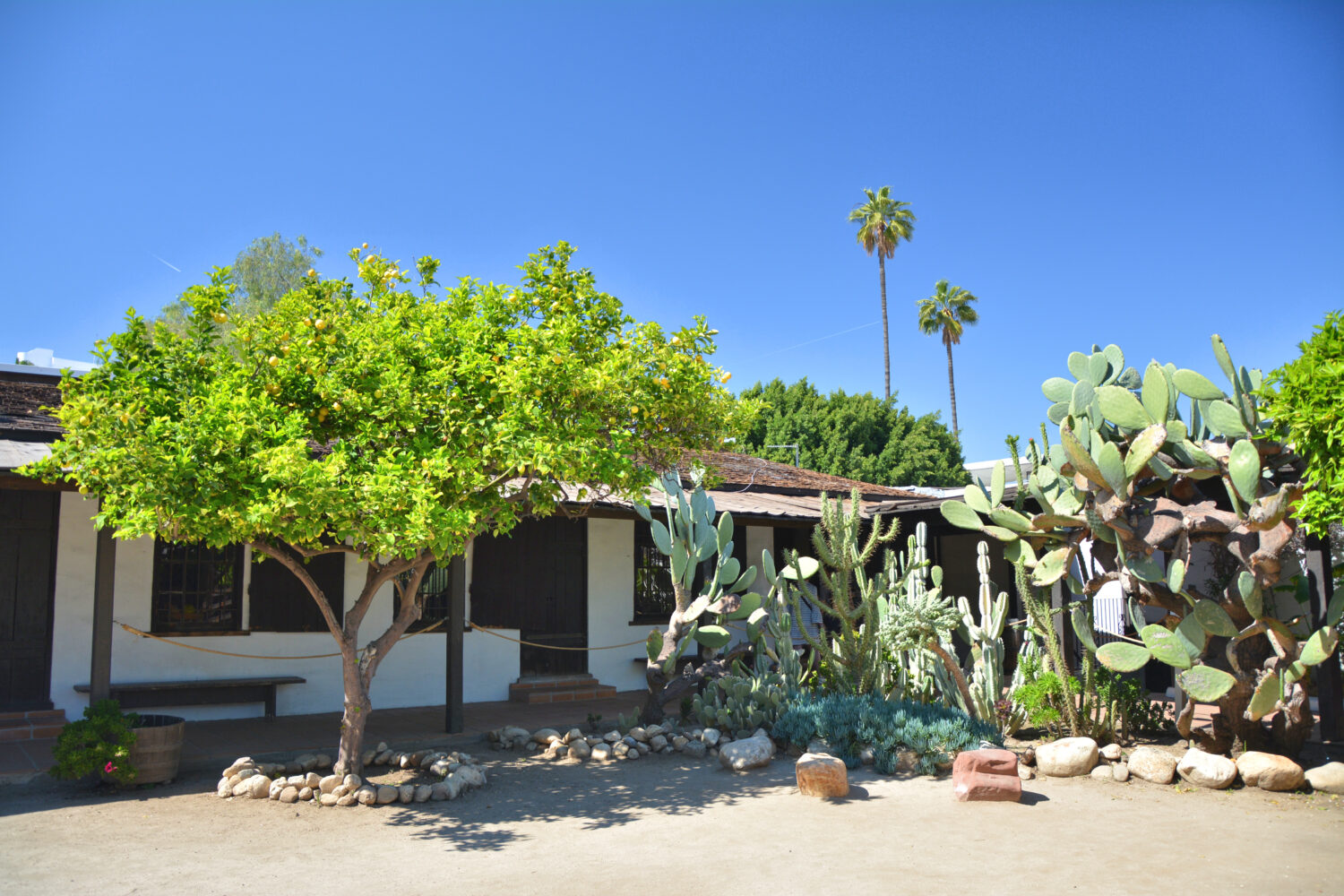The Oldest House Still Standing in Los Angeles is More than 200 Years Old
There are times when Los Angeles, California can feel like a new city. For one thing, it’s the home of Hollywood, the heart of the entertainment industry, a place where trends are set and where glamor lives — very modern. And for another, we know that Los Angeles is one of the Westernmost points in America, meaning that Westward expansion reached this place last. For all these reasons, it may be hard to believe that the oldest house still standing in Los Angeles isn’t new at all. In fact, Ávila Adobe, the oldest house in LA, is more than 200 years old! An incredible time capsule dating all the way back to the period when California belonged to the Spanish Empire, let’s explore this gracious home nestled on Olvera Street in what is now downtown Los Angeles.
Who Built the Oldest House Still Standing in Los Angeles?
Ávila Adobe was built by a major figure of Spanish Colonialism and the Mexican-American War, one Francisco Ávila. Born in the colony of El Fuerte, New Spain (present-day Sinaloa, Mexico), Ávila was a wealthy Spanish rancher and landowner in the LA region in the early 19th century.
It may come as a surprise to learn that Tinseltown was first populated in 1781, just five years after the American Revolution, as a settlement for Spanish citizens coming to live in the empire’s colony — known then as Alta California (New California). Los Angeles’s full name at the time was El Pueblo de Nuestra Señora la Reina de Los Ángeles sobre el Río Porciúncula, or The Town of Our Lady the Queen, Los Angeles, on the Porciuncula River.
In 1810, the Spanish Empire appointed Ávila alcalde del pueblo (that’s mayor of the town) of Los Angeles. And though Ávila only served for a year, he settled permanently in the ranchero community of Los Angeles, which now had a whopping 415 inhabitants. Compare that with 3.85 million today!
Francisco Ávila and the Oldest House Still Standing in Los Angeles
In 1818, Ávila built himself a house right in the middle of the ever-more-bustling settlement. This was, in fact, the third attempt at establishing a Spanish settlement in the region. The first two settled too close to the LA River (Río Porciúncula) and washed away when the river flooded. Ávila, for his part, only grew more part of the landscape when the Mexican colonial government granted him over 4,000 acres of land a few miles West of his new house, near the La Brea Tar Pits. Under his stewardship, the land became a highly profitable ranch: Rancho Las Ciénegas.
Ávila Adobe was an opulent home for its day, befitting Ávila’s status as a political and business heavyweight in the area. It was Ávila’s home base for entertaining, with a full schedule of parties, festivals, holidays and getaway weekends for family, friends, patrons and business partners alike. Linking two pioneer histories, he once hosted the famed American fur trapper Jedediah Smith in 1827. Crossing the Mojave Desert, Jed Smith and his men were the first US citizens to reach California from the East by traveling over land. On this occasion, Ávila Adobe proudly played host to history — though Americans would later take it by force in the coming war between Mexico and the United States. More on that later…
Ávila’s Management of the Oldest House in Los Angeles
We might think of the 19th century as a quieter time; but Adobe Ávila was a bustling place: for one thing, with his wealth and access, Francisco Ávila was able to import anything his heart desired: trading on his end with hides and tallow for soap and candles, he could order up fine goods and furnishings for his estate from Mexico, New England, Europe and Asia. Some of these goods, which included furs, silks, furniture, artwork and even architectural pieces like doors and windowframes, would travel for hundreds of thousands of miles by ship before reaching him. Some took a perilous sailing voyage across the Pacific; others traveled over a Byzantine system of trains and ox-wagons; still others sailed around South America’s Cape Horn in order to reach the affluent and influential Californio.
Though a war, two centuries, several renovations and a governmental turnover separate us from Adobe Ávila and the rich Spanish families who helped found Los Angeles, it’s incredible to know that LA still feels their influence: from street names like Pico Boulevard, named for the last Mexican Governor of California, to something as physical as Francisco Ávila’s actual house.

Image: Studio Barcelona, Shutterstock
©Studio Barcelona/Shutterstock.com
Construction of The Oldest House Still Standing in Los Angeles
The Adobe Ávila is large for houses of the time, reflecting its master’s status as a wealthy and influential Californío — the term used for Spanish gentleman ranchers in Alta California. The adobe is an L-shaped structure with 15-foot ceilings — quite luxurious for the era. The big, sturdy beams necessary to vault the adobe so high came from the Los Angeles River nearby. Remarkably, these beams were sealed and reinforced with tar from the nearby La Brea tar pits. (“Brea” is Spanish for tar.) Ávila had easy access to this valuable resource: as we mentioned above, he had a land grant bordering on the pits from the Mexican government.
The adobe included a family room, living room, bedroom, office and kitchen. It also sported a long porch in back, overlooking a garden patio. This was all before the combustion engine and horses were the primary means of transportation, so you can be sure there was also a well-appointed stable on these grounds.
Air conditioning was an even further way off, two centuries from its invention. To beat the occasionally ferocious Alta California heat, Ávila had the entire home constructed out of three-foot-thick adobe bricks. Between the thick walls and the compacted earthen floor, swept daily until it shone almost like concrete, the home retained cool in summer and warmth in winter.
The Oldest House in Los Angeles and the Mexican-American War
The Ávila Adobe briefly played a significant role in the Mexican-American War, which began in 1846. The whole thing had been fomented by another major American frontier figure, US Lieutenant John “Pathfinder” Fremont, who along with the famed mountain man Kit Carson had blazed the Oregon Trail. Fremont, disguising that he was on duty with the US Government, had ginned up rebellion amidst the white settlers in Alta California. The idea was that America could more easily take California from Mexico if they were responding to a rebellion there, rather than just declaring colonial war. Ultimately, Fremont’s scheme would succeed, and he would become the first Governor of California under American control.
The Oldest House in Los Angeles is Seized by Invading Americans
In July of 1846, the United States Navy joined in the takeover, landing at the Monterey Presidio south of Los Angeles and claiming California from Mexico. Proceeding northward, Commodore Robert Stockton’s sailors tried to take Los Angeles. But this Pueblo was not so easily taken, and the 1846 Siege of Los Angeles failed. America would not succeed in overturning control of Los Angeles until another year of fighting had taken place, in the Battles of San Pasqual, Rio San Gabriel and La Mesa.
When American forces at last marched back into Pueblo Los Angeles on January 10 of 1847, most citizens fled, including Francisco Ávila’s wife, Maria Encarnacion Ávila. She left the adobe in charge of a boy who was to shutter the home and hide within. When Stockton’s force arrived, marching band and all, the martial music lured the boy out of the adobe. When Stockton spied the palatial, abandoned home from which the boy had come, he marched his troops right inside. Ávila Adobe became, briefly, the headquarters of the American incursion into Los Angeles.
Their stay would last only three days: on January 13, the war was settled by the Treaty of Cahuenga, and the garrison was no longer needed.
A 19th Century Earthquake, a 20th Century Restoration
The house remained in the Ávila family until 1868, when Francisco’s youngest daughter moved out. Distant relations occupied it until 1870, when it took damage in an earthquake. (That’s Los Angeles for you, no matter what historical epoch you’re in.) For a while, Ávila Adobe was an unassuming, not especially well kept boarding house. It fell into disrepair, and in 1928, the City of Los Angeles condemned it entirely. These were hard times for the nation, and they fell particularly hard on the Pueblo neighborhood of LA.
That’s when socialite Christine Sterling stepped in. Born in England and recently arrived from San Francisco, Sterling had set her sights on the Pueblo District as ripe for restoration back in 1926. With great foresight, she knew the buildings and plazas here were part of a dwindling Los Angeles history. She felt a duty to preserve it.
She succeeded in doing so. Using her considerable connections, Christine Sterling initiated a campaign to restore the entire district, with Ávila Adobe as its cornerstone. Soon, she had enlisted political and community leaders of the burgeoning young city, and won over The Los Angeles Times to her cause. Not only had she saved the derelict from destruction; the chief of police sent prison inmates to provide labor to clear the plaza! The publicity Sterling generated inspired many Angelenos, notably including the descendants of Californios such as the still-prominent Sepulveda Family, to donate to Ávila Adobe’s restoration.
From Ávila Adobe’s Restoration to Today
Sterling had grown so close to the project that by 1930 that when the whole run-down plaza had been restored to the Mexican-style marketplace it once was, she purchased Ávila Adobe to live in herself! While that might sound a little fishy, we can take some comfort in the fact that Sterling opened the residence for historical tours (a fairer trade when you consider that Ávila Adobe had been an unvisitable derelict for decades prior). In 1953, the State of California bought the Adobe and added it to the El Pueblo de Los Angeles State Historic Park. Christine Sterling would nonetheless live there until her death 10 years later.
Historians point out that the 20th-century restoration added many elements the original house and plaza would not have had, making it less a perfect preservation of history and more museum-like.
In 1971, the Sylmar Earthquake damaged and endangered Adobe Ávila. This forced renovators to reduce its size; however seven of its original rooms remain. It reopened to the public in 1976 and has been open ever since.
How To Visit the Oldest House Still Standing in Los Angeles
The Ávila Adobe is the cornerstone of the Los Angeles Plaza Historic District. Part of El Pueblo de Los Angeles State Historic Park, the public can tour the adobe, featuring furnishings appropriate to the Californio time period (even if they aren’t the actual Ávila family furniture) at 845 North Alameda Street. The Visitor Center is nearby at 128 Paseo de la Plaza. Ávila Adobe is California Historical Landmark Number 145. The LA Plaza Historic District, which contains the Adobe, is also listed on both the National Register of Historic Places and the Los Angeles Historic-Cultural Monuments.
Find out more at Discover Olvera Street.









